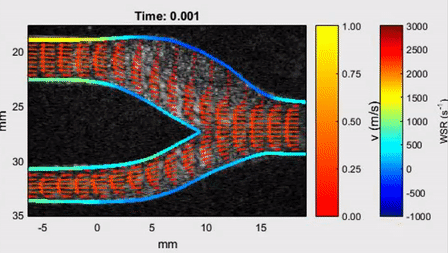Chee Hau Leow, Meng-Xing Tang, “Spatio-Temporal Flow and Wall Shear Stress Mapping Based on Incoherent Ensemble-Correlation of Ultrafast Contrast Enhanced Ultrasound Images”
Ultrasound in Medicine & Biology
https://doi.org/10.1016/j.ultrasmedbio.2017.08.930
Open Access funded by Engineering and Physical Sciences Research Council
Abstract
In this study, a technique for high-frame-rate ultrasound imaging velocimetry (UIV) is extended first to provide more robust quantitative flow velocity mapping using ensemble correlation of images without coherent compounding, and second to generate spatio-temporal wall shear stress (WSS) distribution. A simulation model, which couples the ultrasound simulator with analytical flow solution, was implemented to evaluate its accuracy. It is shown that the proposed approach can reduce errors in velocity estimation by up to 10-fold in comparison with the coherent correlation approach. Mean errors (ME) of 3.2% and 8.6% were estimated under a steady flow condition, while 3.0% and 10.6% were found under a pulsatile condition for the velocity and wall shear rate (WSR) measurement, respectively. Appropriate filter parameters were selected to constrain the velocity profiles before WSR estimations and the effects of incorrect wall tracking were quantified under a controlled environment. Although accurate wall tracking is found to be critical in WSR measurement (as a 200 µm deviation from the wall may yield up to a 60% error), this can be mitigated by HFR imaging (of up to 10 kHz) with contrast agents, which allow for improved differentiation of the wall-fluid boundaries. In vitro investigations on two carotid bifurcation phantoms, normal and diseased, were conducted, and their relative differences in terms of the flow patterns and WSR distribution were demonstrated. It is shown that high-frame-rate UIV technique can be a non-invasive tool to measure quantitatively the spatio-temporal velocity and WSS distribution.
Key Words
Flow measurement; Wall shear rate; Ultrafast ultrasound imaging; Motion effect; Microbubble contrast agents; Contrast enhanced ultrasound; Image tracking
